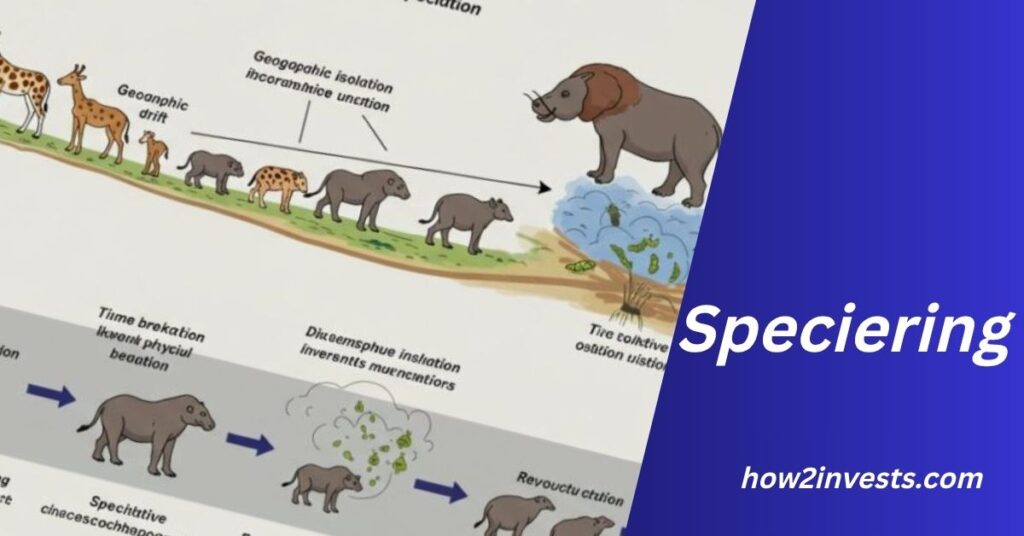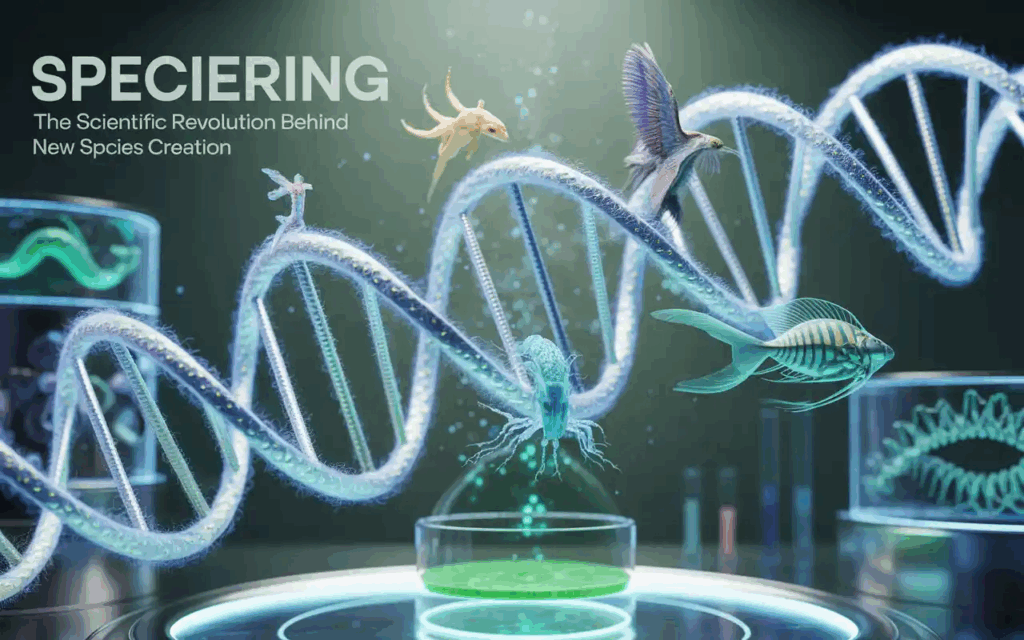Speciering: The Key to Understanding Evolution and Biodiversity

Speciering, also known as speciation, is a fundamental concept in biology that plays a crucial role in shaping the diversity of life on Earth. It is the process by which new species emerge from a single ancestral species, contributing to the richness of ecosystems and ensuring that organisms can adapt to ever-changing environments. Through speciering, species evolve, survive, and interact with their environments in ways that are essential for the health of ecosystems. This article delves into the science of speciering, its role in biodiversity, and how it drives adaptation in a constantly evolving world.
What is Speciering?
Speciering, or speciation, is the biological process by which new and distinct species are formed from a common ancestor. This process can occur in several ways, each leading to the development of species that are genetically different and capable of occupying unique ecological niches. Speciering is central to the theory of evolution, as it explains how organisms diversify over time.
When speciering happens, populations of organisms become reproductively isolated from one another, meaning that they can no longer interbreed. This isolation can occur due to physical barriers like mountains, rivers, or oceans, or through behavioral, temporal, or ecological differences. Over time, genetic differences accumulate in these isolated populations, leading to the formation of new species.

Types of Speciering
Speciering can occur through several mechanisms, each contributing to the formation of new species. These mechanisms include:
Also Read: Nadeshda Ponce: A Comprehensive Guide to Her Journey, Contributions, and Impact
- Allopatric Speciering: This is the most common form of speciation, where a physical barrier such as a river, mountain range, or glacier separates a population. Over time, genetic differences accumulate due to mutations, genetic drift, and natural selection, leading to the development of distinct species. Examples of allopatric speciation can be seen in island chains, where species on each island evolve independently.
- Sympatric Speciering: Unlike allopatric speciation, sympatric speciation occurs without a physical barrier. In this case, new species arise from a single population within the same geographic area. This type of speciation is often driven by ecological differences, where some members of a population adapt to a specific niche or resource, leading to reproductive isolation.
- Parapatric Speciering: Parapatric speciation occurs when populations are adjacent to one another but experience different environmental conditions along a gradient. While they are not fully isolated, the populations experience different selective pressures, which leads to genetic divergence and the eventual formation of new species. This form of speciation is less common but can be observed in species that inhabit heterogeneous environments.
- Peripatric Speciering: This form of speciation occurs when a small group of individuals from a population is isolated at the edge of the species’ range. The small population is more susceptible to genetic drift, which leads to rapid changes in its genetic makeup. Over time, this can result in the formation of a new species, distinct from the original population.
Factors Driving Speciering
Several factors contribute to the process of speciering. These include:
- Genetic Variation: Genetic mutations are the raw material for evolution. Without genetic variation, populations cannot adapt to changing environments, and speciation is less likely to occur. Mutations can introduce new traits that provide a survival advantage, allowing certain individuals to thrive and pass on their genetic material to future generations.
- Natural Selection: Natural selection acts on genetic variation within populations. Those individuals with traits that are advantageous in a given environment are more likely to survive and reproduce. Over time, natural selection can drive the divergence of populations, leading to speciation.
- Genetic Drift: Genetic drift refers to random changes in the frequency of alleles in a population. In small populations, genetic drift can have a significant impact, leading to the accumulation of genetic differences that contribute to speciation.
- Sexual Selection: Sexual selection can also drive speciation, especially in species where mate choice plays a significant role in reproduction. If individuals within a population develop distinct traits that make them more attractive to potential mates, this can lead to reproductive isolation and the eventual formation of new species.
The Role of Speciering in Biodiversity
Speciering is a key driver of biodiversity, as it leads to the emergence of new species and helps to diversify ecosystems. Without speciering, ecosystems would lack the variety of organisms that contribute to ecological balance and resilience. Through speciering, species adapt to specific ecological niches, ensuring that resources are used efficiently and that ecosystems function smoothly.
Also Read: HMS Photovoltaik: Pioneering Solar Energy Solutions for the Future
Speciering also allows species to thrive in a variety of environments. As populations become isolated and adapt to their surroundings, they develop unique characteristics that help them survive in different conditions. This process of adaptation and diversification allows life on Earth to continue evolving and flourishing, even in the face of environmental challenges such as climate change, habitat loss, and competition for resources.
How Speciering Shapes Ecosystems
Ecosystems rely on the interactions between species to function properly. When speciering occurs, new species are introduced to ecosystems, which can alter the balance of interactions between predators, prey, and competitors. For example, the introduction of a new herbivore species can impact plant populations, while the emergence of a new predator can influence the population dynamics of prey species.
Speciering can also contribute to the resilience of ecosystems. As new species emerge and adapt to changing conditions, ecosystems become more flexible and able to recover from disturbances. This resilience is particularly important in the face of global environmental changes, such as rising temperatures, changing rainfall patterns, and human-induced habitat destruction.
Speciering and Adaptation to Climate Change
One of the most significant challenges facing species today is climate change. As temperatures rise, ecosystems shift, and weather patterns become more erratic, species must adapt to survive. Speciering plays a crucial role in this process, as it allows species to diversify and develop traits that help them cope with new environmental conditions.
For example, as global temperatures rise, some species may evolve to tolerate hotter environments, while others may develop new behaviors or reproductive strategies that help them thrive in changing conditions. Speciering allows species to evolve and adapt over time, helping to ensure their survival in the face of a rapidly changing world.
The Importance of Understanding Speciering
Understanding speciering is essential for several reasons. First, it helps scientists understand how species evolve and adapt to their environments. This knowledge can be used to predict how species will respond to future environmental changes, such as climate change, and to develop conservation strategies to protect endangered species.
Second, speciering provides insight into the mechanisms of evolution and the processes that drive biodiversity. By studying speciation, scientists can gain a deeper understanding of how life on Earth has evolved and continues to evolve.
Also Read: Protocolo Operacional Padrão: A Comprehensive Guide to Standard Operating Procedures
Finally, understanding speciering can help us appreciate the complexity of life on Earth and the importance of preserving biodiversity. As human activities continue to threaten ecosystems and species, it is crucial to recognize the value of speciation in maintaining the health of our planet.
FAQs About Speciering
What is speciering?
Speciering is the process by which new species are formed from a common ancestor. It occurs when populations become reproductively isolated and develop genetic differences over time.
What are the types of speciering?
There are several types of speciation, including allopatric, sympatric, parapatric, and peripatric speciation. Each type involves different mechanisms of isolation and genetic divergence.
How does speciering contribute to biodiversity?
Speciering is a key driver of biodiversity because it leads to the formation of new species, contributing to the richness and complexity of ecosystems.
Can speciering happen without a physical barrier?
Yes, sympatric speciation occurs when populations within the same geographic area become reproductively isolated and evolve into distinct species without physical barriers.
Why is speciering important for adaptation to climate change?
Speciering allows species to adapt to changing environments by developing new traits that help them survive in altered conditions, thus contributing to the resilience of ecosystems.
Conclusion
Speciering is a vital process in the evolution of life on Earth. It drives the diversification of species and contributes to the adaptation of organisms to changing environments. By understanding speciering, we gain valuable insights into the mechanisms of evolution, the importance of biodiversity, and how species can thrive in the face of environmental challenges. As we continue to confront global challenges such as climate change, the study of speciering will be essential in guiding conservation efforts and ensuring the survival of species for future generations.




